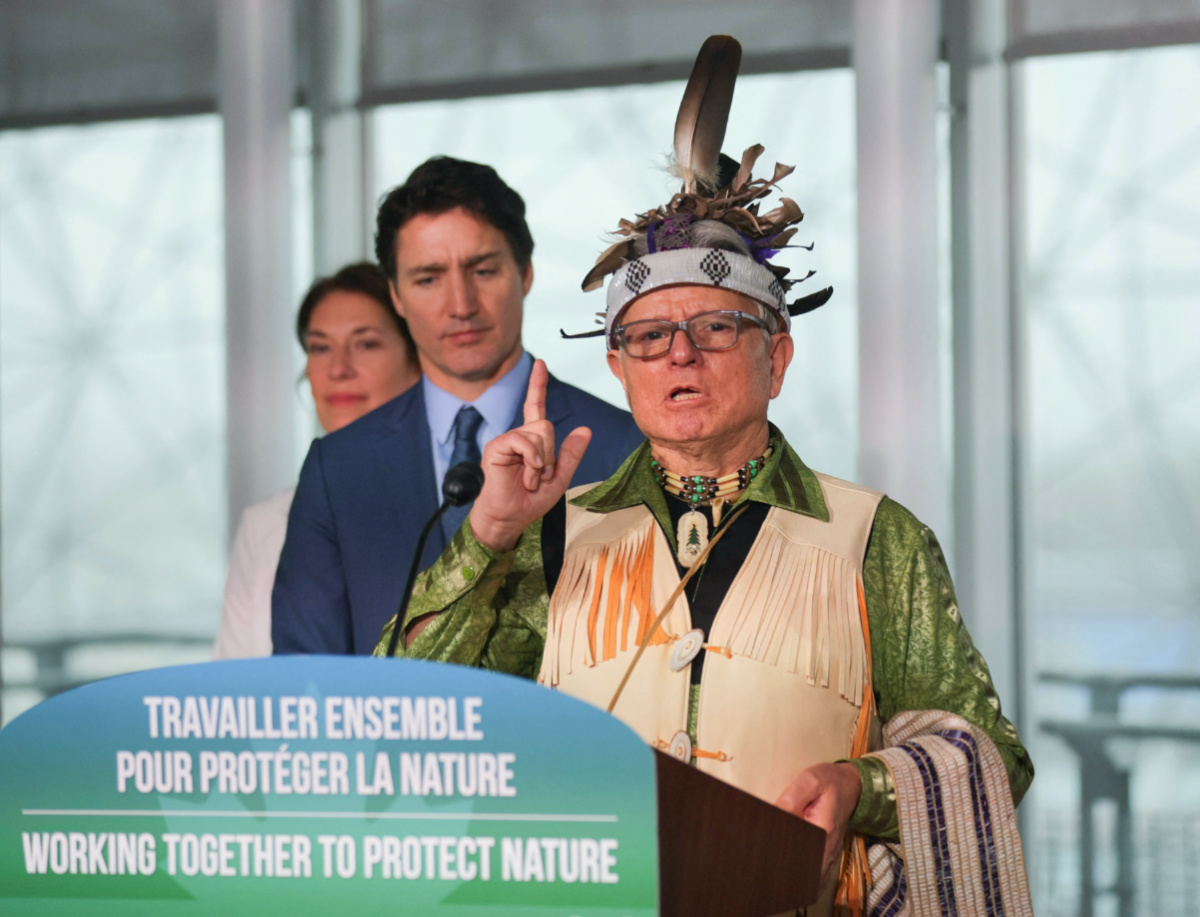Montreal, Canada
Reuters
Negotiations on a deal to protect 30 per cent of the Earth by 2030 are woefully behind in addressing the concerns of native people, whose land holds the majority of the world’s remaining biodiversity, Indigenous advocates told Reuters at the UN nature summit in Montreal.
Indigenous participation is seen as key to reaching that so-called “30-by-30” target within an ambitious new agreement to halt further nature loss and degradation.

Elder Ka’nahsohon Kevin Deer performs a ceremony prior to Canada’s Prime Minister Justin Trudeau making an announcement supporting Indigenous-led conservation COP15 UN Biodiversity summit in Montreal, Quebec, Canada, on 7th December. PICTUrE: Reuters/Christinne Muschi
While Indigenous groups account for about five per cent of the world’s population, their lands safeguard about 80 per cent of Earth’s remaining plant and animal species, according to the World Bank.
At least 40 per cent of the world’s remaining plant species are in trouble. The global insect population is declining at an unprecedented rate of up to two per cent per year.
“This process around biodiversity needs to put Indigenous people at the centre,” said Dinamam Tuxa, a lawyer for Brazil’s largest Indigenous umbrella group, the Articulation of Indigenous Peoples of Brazil.
While Indigenous groups in many countries have only limited authority or recognition over their territories, they often rely on these environments for their livelihoods – through traditional hunting, fishing or harvesting materials from forests such as honey, rubber sap or firewood.
But many of these territories are under increasing pressure thanks to weak conservation laws in some countries and growing demand for natural resources such as metals.
Indigenous groups have a range of concerns about the UN summit negotiations. While some fear the 30-by-30 target could be used to take away their land under the guise of conservation, others have said the 30 per cent goal is not ambitious enough.
Overall, groups agreed that any summit deal should deliver more authority to Indigenous people in deciding what happens on their lands.
“The states must recognise and protect their rights,” said Aquilas Koko Ngomo, spokesperson for the National Alliance for the Support and Promotion of Indigenous and Community Heritage Areas and Territories in the Democratic Republic of Congo.
“The good old ways of ‘we decide what we want, and we don’t care what the Indigenous want’ is becoming more and more a thing of the past,” Canada’s Environment Minister Steven Guilbeault said in an interview.
Canada on Wednesday pledged $C800 million over seven years starting in 2023-24 for up to four Indigenous-led conservation initiatives that could collectively protect up to one million square kilometres (386,000 square miles).
The move would help Canada’s strategy of roughly doubling its protected land to meet the 2030 target. Yet clashes between some First Nations communities and provinces over resource extraction on land these groups want to protect remain obstacles.
The First Nations community of Grassy Narrows in Canada said it opposes what it calls proposed demands by Ontario to allow logging on 20 per cent of their land in 2024.
“We don’t want them to just give us 80 per cent, we want it all,” said Grassy Narrows negotiator Joseph Fobister, of their estimated 7,000-square-kilometre territory. Fobister said Grassy Nations has asked Canada to protect the land as part of 30-by-30.
We rely on our readers to fund Sight's work - become a financial supporter today!
For more information, head to our Subscriber's page.
Ontario’s Ministry of Natural Resources and Forestry said it has worked with Grassy Narrows and other Indigenous communities as it develops options for a new 10-year forest management plan starting in 2024.
Not ambituous enough
Indigenous and community groups also need more direct access to financial backing to conserve land, said Gustavo Sanchez Valle, president of the Red Mexicana de Organizaciones Forestales Campesinas which supports Indigenous and farmers organisations in Mexico.
There have been early trials to give Indigenous people in countries between Mexico and Panama access to funding without government involvement, he said on the sidelines of the event.
Some critics worry that the 30-by-30 target could be used to erode Indigenous rights under the guise of conservation. Such fears were underlined in Africa in October, when a court in Tanzania dismissed a case brought by Maasai villagers challenging their eviction from ancestral lands near Serengeti National Park.
Others, like Tuxa of Brazil and Ngomo of Congo argue that a 30 per cent conservation target does not go far enough to ensure nature’s protection.
Brazil, for example, already designates more than 30 per cent of its territory as protected. Adopting a 30 per cent target at the national level could backfire, Tuxa said, in suggesting Brazil can open more land to development.
“We want this target to be a lot more ambitious,” Tuxa said, declining to give an exact percentage.
– Additional reporting by STEVE SCHERER in Ottawa, Canada





